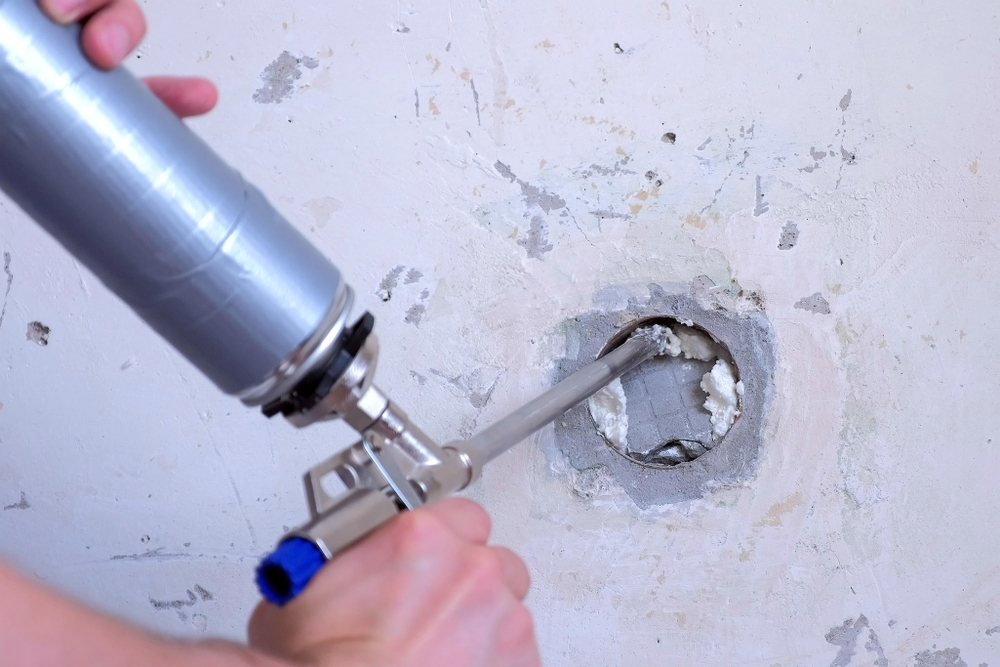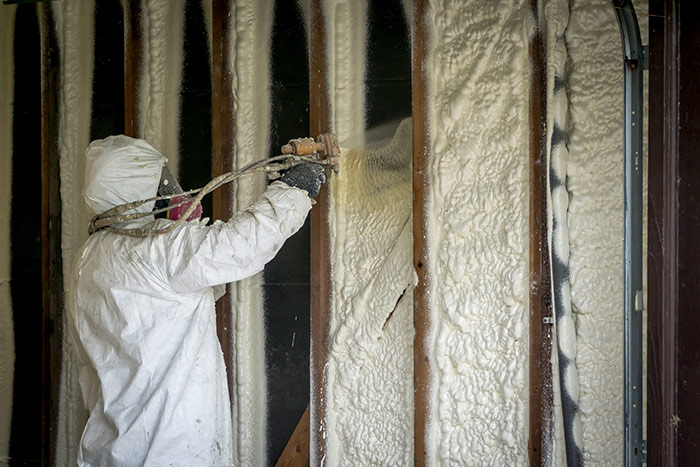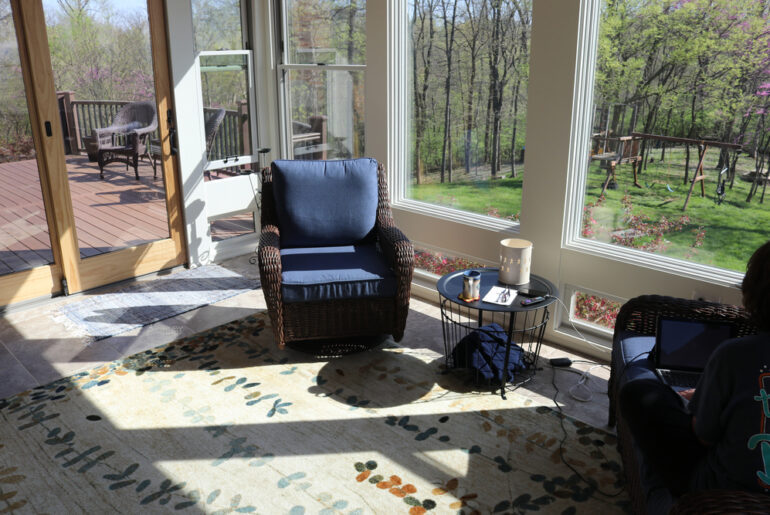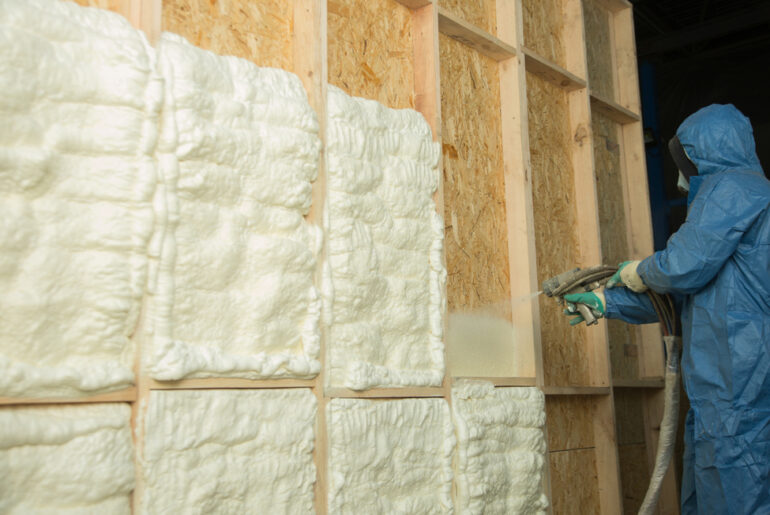It is possible to install expanding spray foam from the outside of a structure. Spray foam is available in a couple of different forms and both can be applied similarly from the outside. However, you’ll need to know how spray foam insulation works to install it effectively.
Spray foam insulation is superior to fiberglass batts, cellulose, and other common insulation materials in almost every way. Spray foam is fast to install, seals the tiny gaps that cost you energy dollars, and offers excellent sound deadening.
Spray foam is typically installed from the interior, using the outer wall sheathing and subfloors as a backer. Sometimes it makes sense to install spray foam from the outside, like around a dormer window or cornice.
Here we will discuss the process of installing spray foam insulation from the outside and offer a few tips to keep your efforts safe and effective.
Can You Install Spray Foam Insulation From The Outside?
You can install spray foam insulation from the outside of a home as long as you follow a few rules. These rules include consideration for the expansion of the foam and having an appropriate backer in place.
Normally, spray foam insulation would be sprayed against the underside of a subfloor, the outer sheathing of a wall, or against the roof decking or drywall in an attic. The process is backward when installing foam from the outside, so you will need drywall or other wall covering installed first.
To be clear, it is technically possible to install spray foam insulation from the outside even if no backer is in place. The backer prevents the foam from expanding past the framework, like the rafters of a vaulted ceiling. This method causes the most waste however, as the over-expanded foam will need to be trimmed away, leading to additional labor and material expenses.
Home builders use this method when the logical order of projects is impractical. This strategy is the most expensive because materials, time, and labor are essentially wasted since the excess material has to be removed and responsibly discarded.
Can I Insulate a Crawl Space From the Outside With Spray Foam?
If you want to insulate your crawl space from the outside, sheet foam foundation panels are better than spray foam. Foam panels like these are made for ground contact, so they do not require a perfectly clean surface and are resistant to moisture and decay.
Closed cell spray foam is commonly used to insulate a crawlspace foundation due to its effectiveness and durability. However, closed cell spray foam generally requires more effort to install than foam panels, like temperature control, cleaning, and dry time.
During initial construction, applying spray foam from the outside is relatively easy on an exposed, dry foundation. However, after the backfill has been replaced, exposing and preparing the masonry for spray foam can require significant time and effort.
Where Can I Install Spray Foam Around My Home?
Open cell spray foam expands a bit more than closed cell, so it is best for sealing around pipes, wires, and other larger perforations. Closed cell foam is best for large areas as it offers more R value per square inch and has limited expansion.
Either is perfectly safe to use around the home, but be careful to stay at least 12” away from any potential source of flame, like a gas appliance. Also stay at least 2” away from light fixtures, junction boxes, and pipe cleanouts.
If working from your roof, be especially careful installing spray foam around recessed can lights. Some versions dissipate heat through the backside of the fixture instead of the bulb. If you cover the fixture with insulation, you could create a fire hazard.
Why Would You Install Spray Foam From The Outside?
There are often situations where installing spray foam from the outside is less expensive and faster than installing it from the inside.
Water Damage
A common home leak occurs near the gutter downspouts, or on the edge of the roof. Removing a shingle or piece of siding is often easier from the roof as it prevents having to work from a ladder.
Elaborate Ceiling Materials
Some homes have vaulted ceilings with coverings like fancy tongue and groove paneling and exposed beams. Insulating these designs can be complex from the inside, but becomes relatively easy from the outside, especially if the roof decking is being replaced anyway.
Limited Access
Some home designs include small nooks that are difficult to access from inside, like a dormer window. Dormers are often built just for looks and provide no easy way to provide maintenance from the inside. Sometimes simply removing a bit of siding and sheathing from the outside is preferable to working in a hot, dark attic.
Why Is Spray Foam Easier to Install Than Other Insulation From the Outside?
Insulation materials need a way to attach to the surface being insulated. Rockwool relies on compression, fiberglass batts use a mounting tab, and loose fill relies on gravity to stay in place.
Loose fill is a poor option for surfaces like vaulted ceilings because it settles. Rockwool does a good job, but requires a tight fit to work. Measuring tight areas can be difficult, resulting in wasted material.
The most obvious choice is fiberglass batts, but batts require access to the mounting tab to stay in place. Since the mounting tab cannot be attached from the outside, installing fiberglass batts would require the addition of wire hangers.
Spray foam requires no mounting tab, fasteners, and expands to tightly fit the space it occupies. Spray foam will adhere to almost anything, even smooth, vertical surfaces. Spray foam installed from the outside will require some form of backer to expand against, like drywall or paneling to avoid wasting the foam.
How Thick Should Spray Foam Insulation Be On Exterior Walls?
Most building codes require a minimum of R-13 insulation inside the walls. Closed cell spray foam provides about an R value of 6.7 per inch, so the walls in most homes would require 2’ of spray foam.
Can I Install Spray Foam From the Outside If There Is No Drywall?
You should avoid installing spray foam from the outside if the drywall or paneling has not been installed. When installing spray foam out of sequence is needed, the common solution is to install a 6mm vapor barrier to the wall studs to retain the foam, which can then be drywalled over. However, this method is usually only used as a last resort as it adds unnecessary expense.
Can I Install Spray Foam If the Siding and House Wrap Is Missing?
You can install spray foam from the outside if the siding or house wrap is missing. You’ll need to remove both anyway to access the void to be insulated, but good practice is to only remove as much siding or house wrap as you have time to replace.
Before you begin, get a roll of house wrap tape. House wrap tape is used to repair any cuts or tears you might make by removing it. House wrap works to encapsulate the entire home and seal the small gaps that leak air. Use the tape to seal any cuts or tears you make.
Is Spray Foam Good For Older Homes?
Spray foam is a good choice for older homes because older homes usually have more gaps and cracks that leak air outdoors. Older homes tend to be drafty and spray foam insulation is the most effective for stopping the gaps and cracks that cause the drafts.
Be careful using spray foam around windows and doors, especially from the outside. If you apply too much spray foam to a gap, the expansion of the foam can break the glass and prevent operation.
How To Insulate Exterior Walls With Spray Foam From The Outside Step by Step
1. Ensure You Have Access
Make sure you have access to any surface you plan to insulate with spray foam. Spray foam is installed in a continuous process, so having to stop and perform demolition can cause your spray foam to harden in the tip.
2. Check the Weather
Always follow the ambient temperature requirements that come with your spray foam. Most spray foams cannot be installed in very cold conditions, so follow the directions carefully.
3. Prepare the Surface and Have a Plan
If you are insulating the underside of a standard built or mobile home, make sure the surface is free of loose debris and mud. Estimate how much spray foam you will need based on your specific product. Each brand may have coverage recommendations, so follow the directions.
4. Practice
Applying the spray foam is easy, but a bit of practice goes a long way. If you can, take a few practice sprays on cardboard and let it cure. You’ll have an easier time estimating the amount to apply if you’ve witnessed the expansion personally.
5. Trim Off any Excess
After the foam has cured, the project is complete unless you need to trim away any overexpanded foam. You can remove over expanded foam with a sharp blade, or use acetone based paint remover.
Can You Use Spray Foam From Outside The Roof?
You can use spray foam to fill small gaps and cracks around your roof. However, spray foam is not as durable as exterior sealant or paint. If you install spray foam from the roof, be sure to trim away the excess and cover it with sealant and/or paint.





